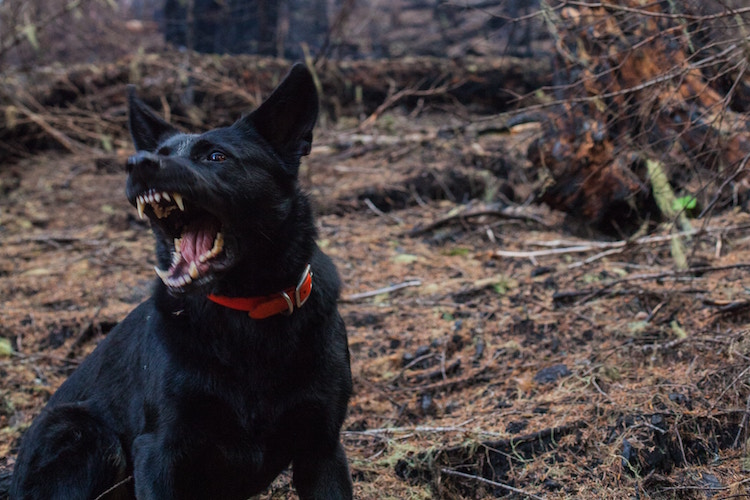One of the most reckless statements spoken in rescue work is this:
The dog bit someone and___________
- it was a little bite.
- it didn’t break the skin.
- it was not the dog’s fault.
Find Out Why The Dog Bite – What Happened?
If your foster dog bites you or someone else, or nearly bites, you cannot brush it off as no big deal.
You/your agency must invest in this dog before adoption. Find out WHY the bite, and find out why before you adopt your foster dog to anyone. Telling an interested party, “Oh by the way, he bit my neighbor, we aren’t really sure why. But he didn’t break the skin. She wasn’t mad about it, but you should be careful.”, isn’t enough, and honestly? It is reckless.
We’ve Become Dangerously Tolerant of Dog Bites
Dog bites are on the rise. We are a more pet-friendly society. Our dogs go with us everywhere: to the sidewalk cafe, the home improvement store, on hiking trails, to family functions, and on our vacations. In addition, we live more closely to one another.
In a 2015 article, the United States Census Bureau states “US cities are home to 62.7% of the population” and that population lives all tight and cozy in just 3.5% of land area. In the American Pet Products Association’s 2017-2018 National Pet Owners Survey, they report 60.2 million households own at least one dog, with a total of 89.7 million dogs living in households across the US. (Source: Insurance Information Institute)
A lot of dogs live in close proximity to one another.
Increased Tolerance Of Poorly Socialized Dogs Is Not Always A Good Thing
As a society, we tolerate more unruly behavior than ever before. Bullying and rudeness are rampant on social media. We put up with noisy conversation in public venues, and our tolerance for noise, in general, is at an all-time high. Our acceptance and forgiveness of behaviors from poorly trained dogs are also trending off the charts.
Whether it’s due to a busy lifestyle, inaccessibility (including cost) to obedience training classes, lack of awareness, or a belief that “dogs are people, too” and we should “live and let live”, more dogs probably equals more untrained dogs. More untrained dogs and untrained humans translates to more dog bites. More near misses.
The Role Of Animal Welfare Agencies
Dog welfare agencies, including dog rescue non-profits, share a responsibility to the community for the dogs they place. I don’t think we’ve fully embraced that responsibility. It’s certainly a topic for discussion.
“Adopt More So We Can Save More” Is Bad Math
I’m writing to you from the Deep South, and the sheer volume of homeless dogs here leaves me speechless. We are damn busy rescuing dogs. Rescuers feel increasing pressure to “save them all” as part of the no-kill movement, and many folks are out there trying to save them as fast as they can. BUT. Here’s the flip side to the coin: You must find new homes for all of them.
The more we adopt out, the more we can save? Um. Careful. Agencies adopt dogs into the community 1 day, 3 days, 5 days post arrival without any time investment. The community absorbs the responsibility of the risks a poorly socialized dog brings to families, neighbors, and other pets. I’m not sure it’s fair. I know it isn’t fair.
“But, we are a dog rescue. and these are rescue dogs.” “We are only volunteers.”
YUP. And your adopters view you as an animal specialist whether you view yourself as one or not.
Families Do Not Want A Rescue Dog
TRUTH BOMB. Families don’t want to adopt a rescue dog. They want to adopt a family pet. While many people will adopt a dog that needs manners training or maybe hasn’t quite mastered house-training, and most will accept a “quirk” like fear of baseball hats or a love of socks – rare is the family that wants a “project dog”.
It should go without saying – families really do appreciate full disclosure and guidance when you offer them a dog that has a bite history.
A few real adoption scenarios to share and then I’ll jump off my soapbox.
- “I just adopted a 7-month-old labrador puppy. She’s terrified of my boyfriend, and he is responsible for her mid-day potty breaks.” (can you say bite risk? A rescuer didn’t know this puppy was afraid of men? Why?)
- “We adopted a dog who does not like her neck touched. We live in an apartment, and can’t get the leash on her collar to take her out for potty.” (bite risk, not to mention the inconvenience of cleaning up potty on the floor, among other “misses”)
- “I know you said [this dog] does not like to go in his crate and to use treats to lure him in, but I was in a hurry and I tried to physically put him in the crate. He left puncture wounds on my hand” (dog with prior bite history has now delivered a level 3 bite. Dog was returned to rescue and lived the remainder of his life in a small, small world.
We must increase our competence in dog behavior & observation, dog bite risk/triggers and dog bites. I fear there will come a time when rescue organizations will be held accountable and liable for their adoption placements.
Reasons Dogs Bite
To be a simpleton for a minute, dogs bite for only one reason:
TO COMMUNICATE
It’s our job to figure out what they are saying.
Dogs bite because they are in pain or they don’t feel well. Or they bite because they are annoyed and want something or someone to stop. Arousal and over-excitement can cause a dog to bite. They may bite when they are startled or scared. And dogs can bite if they are overprotective of something of value they perceive is about to be taken away (resource guarding). Dogs can bite because they truly are unstable. These dogs are unpredictable, difficult if not impossible to rehabilitate, and are hard to safely manage.
Grumple”Stan”skin
Dogs can bite because they are grumpy. We accepted a dog into rescue that would bite, sometimes leaving a bruise, if you disturbed him while he was sleeping. He was not startled into waking up, nor was he in pain. Stan seriously did not want to be disturbed during his nap. We trained him to take his naps on his own bed and not the sofa; and we made darn sure we delivered the message to his adopter: “Stan WILL bite under these conditions, and here’s what we’ve trained him to do so he’s less likely to bite you.” Oh. And no kids around when Stan sleeps. (Stan went to a kid-less home)
Communication Tools
We must be mindful in our management of dog behavior so we don’t inadvertently condition a dog to skip over a tool of communication. For example, we think Spike is being “rude” for air-snapping at Bruno because Bruno moved too close to Spike’s toy, so we scold Spike for air-snapping instead of calling Bruno away from the toy. Spike is likely to learn he shouldn’t air-snap to communicate. Spike already knows Bruno didn’t listen to a low growl or a repositioning of his body when Spike is asking for him to step away from the toy. An air-snap no longer an option (we said “no” don’t do that) Spike could go to the next level; a lunge/grab/bite.
The other point in the above scenario is that the human maybe didn’t observe the many other communication signs Spike exhibited before resorting to the air-snap. An air-snap is a normal communication tool for a dog. We do not want to tell them they cannot use it.
To read more about how dogs communicate, check out Victoria Stilwell‘s article on the topic: Canine Body Language.
Dog Bite Intensity And Bite Control
There is a rating scale available to help grade the severity of a dog bite. It’s called The Ian Dunbar Dog Bite Inhibition Scale. You can Google Ian Dunbar (he’s a GREAT resource for you die-hard puppy fosters!) and you can get a PDF form of the Bite Inhibition Scale here.
Mr. Dunbar wastes no words on his recommended response to low-level bites: He recommends TRAINING – for the dog, and for you. 99% of dog bites leave low level “little” “not bad” “didn’t break the skin” “only bled a tiny bit” “just left a bruise” injuries, or leave no injury at all, and yet this dog need intervention, according to Dr. Dunbar. Even if the intervention is teaching the human new observation skills and improved management of the environment. So, if little Muffin bites at your ankles in excitement after you come home from work, you may want to put her adoption on hold for a bit until you can provide her some practice with alternative behaviors when expressing her glee.
Some bites and bite injuries happen because a puppy was never taught bite inhibition. One of the main reasons you keep a puppy with its mother well beyond the time the puppy is no longer nursing is to allow the mother – and littermates – to teach skills. A puppy may not need it’s mother for life-sustaining nutrition, but it still needs her to teach a variety of social skills, including bite inhibition.
All puppies in rescue should begin bite inhibition training as soon as they are able.
My Otis is such a dog – he clearly left his littermates and his mama way too early and has several deficits. One deficit is his zero-to-90 hyper-arousal which comes with mouthing. He play bites HARD. This play biting got him in the slammer – he was attending a birthday barbeque where little ones were running and squealing and Otis was allowed to run and play, too. He latched on to the arm of a small, tender-skinned child. Animal Control seized him, placed him on a 10-day bite hold, and scheduled the euthanasia, as the particular shelter housing him had a no-bite-history adoption policy. Rescue pulled Otis from the shelter with two hours left before his scheduled death. All because he was playing, and hadn’t learned bite inhibition. Today, Otis can still slip into hard play biting if I’m not paying attention to his level of arousal. He will always be an at-risk dog.
The “One Free Bite” Dog Bite Rule
I’ve heard it said many times, “Every dog gets one free bite.” Meaning, the first bite is excused. A dog gets one opportunity to deliver its message by biting. An owner gets one opportunity to understand that bite. Afterward, the owner of the dog is responsible for any future bite. This “rule” is actually an old law brought over from Great Britain and became the law of the land on the day of the United States’ Independence. Today, some states still have a “one free bite” law on their books while other states have changed their laws making pet owners quite liable for their pet’s behavior. Interestingly, Mississippi is one of those states. My Otis was detained in Mississippi. He wasn’t protected by the one-free-bite rule.
Owners whose dog bites another can be covered for any liability under their homeowner’s insurance policy. Many breeds that are excluded from coverage, and as insurance claims and payouts increase, home insurance policies are responding with tighter rules, higher premiums, and exclusionary clauses. Once a dog has a recorded bite history, coverage can be redefined or denied.
Nearly 1 in 5 people who are bitten by a dog require medical attention. (Center For Disease Control)
“Homeowners insurers paid out over $686 million in liability claims related to dog bites and other dog-related injuries in 2017, according to the Insurance Information Institute (I.I.I.) and State Farm®. The average cost paid out for dog bite claims nationwide was $37,051 in 2017. The average cost per claim nationally has risen more than 90 percent from 2003 to 2017, due to increased medical costs as well as the size of settlements, judgments, and jury awards given to plaintiffs.” These award amounts are trending upwards. Some cases in Florida involve damage done by dogs knocking down the elderly or children, causing injury. Insurance Information Institute
The consequences to families whose dog has delivered a bite or injury can be significant.
Responsible Adoption With A Dog Bite History
Is This Dog Adoptable?
Not every dog with a bite history is appropriate for adoption. Nor is every dog is able to be rehabilitated. One dog in the rescue where I’ve volunteered has been in residence for over 7 years. She lives in a permanent foster home and is integrated, but is not safe to be away from the expertise of rescue. There are plenty of dogs in rescue organizations around the country that are available for adoption and have no business being re-homed. If the goal is to keep them alive, they should remain alive while managed under the umbrella of rescue. Is your goal is rehabilitation? Make sure you are using a qualified animal behaviorist. The animal training industry is unregulated and some trainer’s techniques are torturous and non-transferrable. Choose wisely. A good behaviorist will look you in the eye and tell you when a dog needs euthanized and will just as firmly tell you a dog has great potential with training.
Should Every Dog Have The Opportunity To Be Adopted?
Ask that question to any credible trainer or Certified Animal Behaviorist or veterinarian who works with dogs with behavioral issues. Reactive dogs, dogs with extreme prey drives, dogs that resource guard. Too often, it’s a dog adopted from a rescue organization and rehabilitation training isn’t going as hoped. When that happens, it isn’t the rescuer delivering bad news. They got a win: an at-risk dog found an adopter – an adopter who wants to help an unfortunate dog with a sad story.
No, it’s the trainer or veterinarian who has to deliver the heartbreaking news. After significant investment from family and professional, there’s a realization. A tragedy, maybe. The hard truth reveals this behavioral dog cannot be safely rehabilitated. The dog isn’t happy – never relaxed, but always worried, always on guard. Safety management plans are deemed too risky. So a trainer, whose invested their very best (and their heart) into this dog, has to then help an adopter (who loves.their.dog.to.the.bone) make a heart-wrenching decision: A decision a rescuer should have made in the first place.
Is This Adoptable Dog Likely To Bite Again?
You should possess the ability to answer this question with a good bit of confidence. If the answer is yes, ask yourself if you were to take this dog off of the “available for adoption” list for a while to focus on some training, could you significantly reduce the chances that dog might bite. Or, are you bettin’ your life (and your house!) that your adopter is 150% all-in on seeking professional behavioral services for this dog and you are going to be very involved in the follow-up to monitor outcomes? Placing a dog with a bite history knowing the dog could easily bite again should be done rarely, carefully, thoughtfully, with the full support of your agency’s Board of Directors and your legal team. I know donated funds are an issue for many rescue organizations, but I believe that every dog with a propensity for biting should be evaluated by an animal behavior professional before considering adoption.
When Finalizing An Adoption, Put Your Information In Writing And Be Prepared For It To Be Overlooked or Dismissed.
Adopting a dog from a reputable rescue is quite a feat. You know that! Rarely does it happen in a day or few, and never does it happen without a lot of information exchange between two parties to complete the approved-to-adopt process. Only a fraction of the information you share with an adopter is retained. I’ve participated in many conversations with adopters regarding a dog behavior or bite trigger. They don’t hear me, or they hear me and don’t believe me. And…. I get a call a week or two later: “Sport snapped at me when I [did this]” – and I remind them of the conversation when I told them about that very trigger. Most of the time the adopter and the rescue rep are able to review the information, the rescue feels confident, and the adoption will hold. Sometimes the best decision is for the dog to come back into rescue.
Information overload and more concerning – information dismissal – is reason enough to design a well-thought protocol for assessing, training, and identifying best placement for your rescue dogs. Be intentional in your work with your rescued dogs. Be intentional in your assessment, intentional in your response to behaviors, and intentional in your placement.
Popular Posts
- HOW TO CHOOSE A DOG RESCUE AGENCY
- ULTIMATE GUIDE TO FOSTERING: 10 SKILLS YOU NEED
- VOLUNTEER IF YOU CANNOT FOSTER




